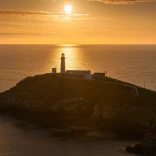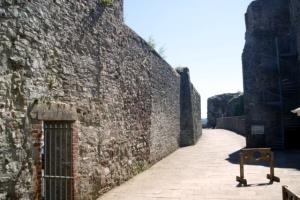The castle at Carmarthen, on its rocky eminence overlooking the River Twyi, must have dominated the medieval town just as, a little way to the east, the Roman fort must have dominated the Roman town a thousand years before. Giraldus Cambrensis tells us that even in the late 12th century, parts of strong walls of the ancient city of the Romans were still standing.
The castle was converted into a prison in the 18th and 19th centuries, and the building of the Council offices has also not helped its appreciation as a military entity. However, enough remains to make a visit worthwhile.
The castle is first mentioned in 1094, when the name Rhyd y Gors is used. The earliest castle, built by the Norman William fitz Baldwin, may have been sited elsewhere perhaps further down the river. After 1105 the annals refer to Carmarthen by name, so by then certainly, the Norman castle was on its present site.
The castle evidently became important early on, and passed into the hands of the crown. Carmarthen quickly became the administrative center of south-west Wales as it had been under the Romans, and inevitably underwent a series of attacks and rebuilding episodes during the turbulent struggles between Welsh and English in the 12th and 13th centuries.
Among these episodes was the capture and destruction of the castle by Llywelyn the Great in 1215, after which extensive rebuilding work was undertaken by William Marshal the younger earl of Pembroke, who had re-captured the castle in 1223. It may have been at this period that the massive stone defences were built on the site of the original motte.
A survey of the castle in 1275 refers to a dungeon, a great tower, a gatehouse, hall, kitchen and chapel, all of which apparently needed repair, and from 1288-9 much rebuilding took place; this probably included the construction of the stone curtain wall.
Further buildings were added in the 14th century, including the present gatehouse and the south-west tower. The castle remained important in the 15th century and required considerable repair after being sacked by Owain Glyndwr in 1405. By 1456, Edmund Tewdwr (father of Henry VII) had gained possession of Carmarthen Castle as the king's representative, and died here in that year.
The castle became the county prison in 1789 and the building of the gaol in 1869 effectively destroyed the open space of the outer ward. It is probably best to look first at the earliest surviving structure, the motte. The exterior of the motte may be seen by leaving the car park and walking along the small path by the side of the old gaol wall to the left. The stone-revetted motte is immediately in front of the path, and two of the semicircular corner towers are visible.
Further along the path are two late buttresses, which are known to be on the site of another of the towers. The curtain wall, evidently much rebuilt, connects the motte with the gatehouse. The 14th century gatehouse has been partially blocked internally, though the old arch above the gate passage is quite evident in the masonry. The outer portcullis groove and the arches over the murder holes can be seen from the outside. On either side of the passage are two gate towers with battlements supported by a corbel table. The upper floor of the gatehouse housed the constable of the castle. Beyond the south-west tower is a small, square tower with a vaulted basement, standing with a stump of the old curtain wall attached.
Surprisingly few traces survive of the medieval town of "New Carmarthen," which grew up around the castle. The town walls and four gates, the Augustinian priory and the Franciscan house of the grey friars, have all disappeared. A small section of Civil War defences, thrown up by the Royalists, survives on the south-west of the town. They are known as "The Bulwarks," and consist of an earthwork bank and a well-preserved four-sided bastion.






